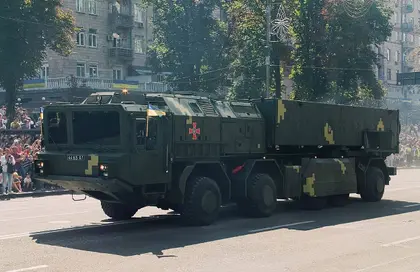A day after a wave of unexpected and destructive strikes against a critical Russian air force air base in Crimea, evidence was mounting on Aug. 11 that the weapon used most likely was a highly-capable Ukraine-produced missile system possibly thought by Moscow not to be in operation.
Saky air base, as the missile flies, is at least 150 kilometers from the closest launch sites usable by Ukrainian Armed Forces (UAF) units. Until Tuesday, it was unclear to the Kremlin and independent observers alike whether Ukraine had a weapon capable of shooting even close to that distance.
- See the latest war in ukraine update in the Kyiv Post’s news bulletins released today.
- Find the newest Ukraine news pieces that came out today.
JOIN US ON TELEGRAM
Follow our coverage of the war on the @Kyivpost_official.
Ukrainian military sources on Wednesday said that the Saky strikes destroyed at least nine Russian air force planes parked at the base, and detonated multiple munitions depots. Kyiv official sources made no comment on how, and by what means, the attacks were carried out.
Andriy Tsaplienko, a high-profile Ukrainian military journalist, in an August 10 Telegram post said that the only possible tool Ukraine has to cause all that damage, at that range, was a weapon called the Grim heavy missile launcher. Other sources said the evidence supporting Grim systems as is not conclusive.
Also known as Sapsan, the truck-mounted Grim system was developed by Ukraine’s Dnipro-based Yuzhmash aerospace company from 2013-2019. Twin missiles carried aboard would have a range of at least 280 km – twice the reach of the Ukrainian army’s aging Tochka-U rockets, and four times the range of US-delivered HIMARS missiles known to be operated by the Ukraine Armed Forces. Each Grim missile, per design, carries close to a half ton of explosives, and is, per Yuzhmash advertising, capable of pulverizing 10,000 square meters of target area.

Trump Makes 90 Day Foreign Aid Freeze – Ukraine Military Support Supposedly Untouched
Fielding the Grim was slow and difficult, due to limited financing of Ukraine’s defense sector, the exacting tolerances in ballistic missile manufacturing, and Kyiv’s loss of access to Russian-manufactured parts after Russian invasion of Crimea and Donbas in 2014. By 2019 only two systems had reportedly been built: one a test copy for the Ukrainian military, and one a sample for overseas arms sales, possibly to Saudi Arabia. In 2021 Ukraine’s Defense Ministry announced it intended to field a “division” of Grim systems, without saying when or how the systems would be paid for.
Some well-informed military observers suggested talk of Grim missiles hitting Crimea could be misdirection. “I think a Grim is just a clever cover for the actual means to deliver that long-range strike (on Saky),” said Oleksii Izhak, an analyst for Ukraine’s National Institute of Strategic Research. “Targeting and control systems need some testing and (the missiles) were hardly tested in real flights.”
“But it (combat use of multiple Grim systems against Saky) is possible…and I hope it is,” Izhak added. He is a former Yuzhmash staffer.
Russian state media has flatly rejected even the possibility Ukraine could manufacture a world-class ballistic missile system. Following the Saky strikes, Kremlin propaganda platforms have offered explanations for the blasts split roughly evenly between a fire started accidently by a Russian air force member, and delivery of long-range American precision rockets to Ukraine, notwithstanding flat, White House denials, first made in April, that the US will not transfer long-range strike systems to Ukraine.
Since invasion in February, the Russian military has hit Yuzhmash only once, on July 15, launching at least four long-range cruise missiles at the site, killing three people and damaging some buildings. Otherwise, notwithstanding more than 3,000 missiles fired at “strategic” targets across Ukraine, and the Kremlin’s announced goal of destroying all Ukrainian military infrastructure, Moscow has left Yuzhmash untouched. One possible explanation may be in the plant’s design: As Soviet-era critical military infrastructure, Yuzhmash’s production lines are widely thought to be deep underground, in sites designed to resist a nuclear strike.
What Yuzhmash is manufacturing and how capable the production lines are of holding out against bombardment are Ukrainian state secrets, as is the number of Grim systems operated by the UAF, and where they are located.
Open-source news reports and hundreds of videos and social media posts following the Saky strikes showed between ten and twelve powerful explosions in and around the Saky air station. The scale of each of the detonations – among other damage blowing out automobile windows a half-kilometer away – was consistent with the Grim missile’s 500 kg warhead. Alternatively, but theoretically, aerial bombs or, even less likely, Ukrainian saboteurs, theoretically could also have been behind the blasts.
The US newspaper New York Times, in a Tuesday article, cited an unnamed Ukrainian official as saying “a device exclusively of Ukrainian manufacture was used” in the Saky strikes. If the Grim was used in the Saky strikes, given the quick succession of the explosions on Wednesday afternoon, it would likely mean Ukraine is operating at minimum six systems – three times as many as were thought to be operational in 2019.
Ukrainian official sources offered tongue-in-cheek denials Kyiv had anything to do with the Saky blasts at all. A statement from Ukraine’s Emergency Situations Ministry recommended Russian military personnel serving at Crimean air bases “should be more careful where they throw cigarette butts.”
You can also highlight the text and press Ctrl + Enter










